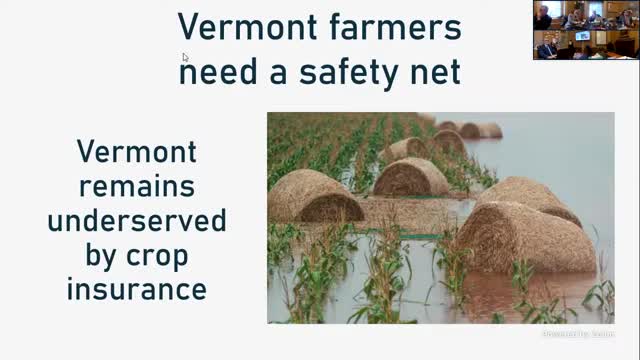Vermont farmers struggle with low crop insurance enrollment amid increasing climate risks
February 28, 2025 | Agriculture, SENATE, Committees, Legislative , Vermont
This article was created by AI summarizing key points discussed. AI makes mistakes, so for full details and context, please refer to the video of the full meeting. Please report any errors so we can fix them. Report an error »

Vermont farmers are facing a critical challenge as only 7% of farms in the state participate in federal crop insurance programs, leaving them vulnerable to severe weather and market fluctuations. This stark statistic was highlighted during a recent Senate Agriculture meeting, where officials discussed the pressing need for improved crop insurance options tailored to the unique needs of Vermont's agricultural landscape.
The meeting revealed that while over 90% of planted acres in the U.S. are covered by crop insurance, Vermont's enrollment is alarmingly low, with only 9.4% of the state's farm acres insured. This disparity has prompted the USDA Risk Management Agency (RMA) to initiate targeted outreach programs aimed at educating farmers about available insurance options. However, the complexity of enrollment and the limited number of crop policies available in Vermont have hindered participation.
In 2023, Vermont farmers suffered over $44 million in losses due to catastrophic weather events, with 70% of those surveyed reporting no crop or livestock insurance. The current federal programs, including the Noninsured Crop Disaster Assistance Program (NAP), have been criticized for their low payouts and complicated eligibility requirements, which often do not meet the needs of small and specialty crop farmers.
Officials emphasized the urgent need for a redesign of crop insurance programs to better serve Vermont's diverse agricultural community. The discussion underscored the disconnect between existing insurance structures and the realities faced by local farmers, many of whom sell directly to consumers at higher margins that are not recognized by federal programs.
As Vermont grapples with increasing weather-related challenges, the call for a more effective safety net for farmers has never been more critical. The meeting concluded with a commitment to explore solutions that would provide immediate financial relief and support for farmers to sustain their operations in the face of ongoing risks.
The meeting revealed that while over 90% of planted acres in the U.S. are covered by crop insurance, Vermont's enrollment is alarmingly low, with only 9.4% of the state's farm acres insured. This disparity has prompted the USDA Risk Management Agency (RMA) to initiate targeted outreach programs aimed at educating farmers about available insurance options. However, the complexity of enrollment and the limited number of crop policies available in Vermont have hindered participation.
In 2023, Vermont farmers suffered over $44 million in losses due to catastrophic weather events, with 70% of those surveyed reporting no crop or livestock insurance. The current federal programs, including the Noninsured Crop Disaster Assistance Program (NAP), have been criticized for their low payouts and complicated eligibility requirements, which often do not meet the needs of small and specialty crop farmers.
Officials emphasized the urgent need for a redesign of crop insurance programs to better serve Vermont's diverse agricultural community. The discussion underscored the disconnect between existing insurance structures and the realities faced by local farmers, many of whom sell directly to consumers at higher margins that are not recognized by federal programs.
As Vermont grapples with increasing weather-related challenges, the call for a more effective safety net for farmers has never been more critical. The meeting concluded with a commitment to explore solutions that would provide immediate financial relief and support for farmers to sustain their operations in the face of ongoing risks.
View full meeting
This article is based on a recent meeting—watch the full video and explore the complete transcript for deeper insights into the discussion.
View full meeting